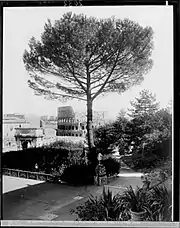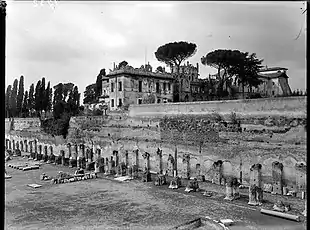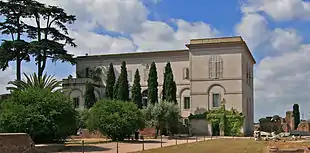Villa Mills
Villa Mills, formerly known as Villa Mattei al Palatino, was a villa in Rome located above the Palatine Hill between via di San Bonaventura and via dei Cerchi, in the Campitelli. The structure was built over the Domus Augustana and the Domus Flavia. It was demolished at the beginning of the twentieth century to allow excavations of the archaeological site.[1]
.jpg.webp)
History
%252C_Villa_Mills_on_top_of_the_Domus_Augustana_(2).jpg.webp)

In the sixteenth century, the area where Villa Mills was located was essentially made up of gardens and vineyards, part of the famous Orti Farnesiani on the Palatine Hill created by Cardinal Alessandro Farnese.[2]
A small country house was built by the Stati family above the ancient Domus Augustana, with a small loggia decorated with frescoes by Baldassarre Peruzzi - depicting the zodiac, muses, and other classical themes - and by other painters from Raphael's workshop. Later the villa passed through the hands of the main families of Rome, such as the Colonna, the Mattei di Giove, the Spada and the Magnani, and other lesser known owners,[3] and was known as Villa Mattei al Palatino or Villa Stati- Mattei. In 1818, the property was bought by Charles Andrew Mills (1770-1846) and the English archaeologist William Gell(1777-1836).[4] In 1824 the two restored the small open Renaissance loggia which housed Peruzzi's frescoes.[5] Later on, medallions with a rose, a thistle, and a clover were placed on the pendentives of the painted arches of the first floor, while the pillars of the entrance gate were decorated with thistles.[6][7]
In 1846, [lower-alpha 1] Robert Smith (1787-1873), a former officer of the East India Company, bought Villa Mills after marrying a French heiress, Julia Adelaide Vitton de Claude, and after the birth of the couple's son, Robert Claude, in Venice in 1843.[8]
Mills is believed to have added Gothic elements to the villa using the services of a "fashionable British architect" to create "pinnacles, battlements, cornices, and cloisters" and also two Chinese pagodas, painted yellow, over augustane spas [9] Given the lack of evidence of Mills' "changes", it can be argued that it was Smith and not him who was responsible.[10] Although some evidence suggests that the villa was built by Mills, as the thistles in the decoration indicate, a reference to its Scottish origin,[11] the building reveals much more of Smith's mixed style, with Gothic and Italian elements linked to other Indians in a central rotunda flanked by two octagonal towers with a loggia with arches at the bottom: with the ruins of ancient civilizations under the building and a grandiose panorama above, the design of the villa is reminiscent of a bungalow in Delhi. In confirmation of this thesis, the guests of the villa during the period in which Charles Mills was alive did not mention the "eccentric" aspect of the complex, which surely would have done if the modifications had already been present.[12] In these accounts, the garden appears to have been the most attractive point of the villa rather than the architecture of the palace, making it all the more likely that the new additions were the work of Smith and not Mills.[7][13]

In 1856, the property was sold to the sisters of the Visitation,[14] and enlarged by Virginio Vespignani. However, being built over the ruins of the ancient imperial palaces of the Palatine, the villa incorporated in its private property precious evidence of the early stages of the Roman Empire.
Although excavations had been carried out at the site in the mid-18th century,[3] at some point the research and preservation of knowledge of the earlier ages of the city became a priority through much deeper exploration than the simple summary inspections conducted until then. The decision to demolish the villa therefore became inevitable, an operation carried out under the direction of the archaeologist Alfonso Bartoli, responsible for the excavations of the Roman Forum and the Palatine Hill, who claimed that the new discoveries would amply justify the destruction of the magnificent building. The excavations conducted between 1926 and 1929 were very productive and, consequently, the only surviving structure of the Renaissance complex is a small lodge left over from the old palace, and a more recent structure, already built by the sisters of the Visitation, which has become the seat of the Antiquarium of the Palatine.[3]
After the demolition of Villa Mills, systematic excavations were started on the site and the residences where the first Roman emperors lived were brought to light: the Domus Augustana, which was the private part of the palace with the Augustan's private apartments and baths, enlarged by Domitian .

After the demolition of Villa Mills, one of the few preserved structures was called "Loggetta Mattei" or "Casina Farnese", which had housed the frescoes of Baldassarre Peruzzi, and a nineteenth century building where the Palatine Museum is located.[15]
Notes
- Charles Mills died in 1846, therefore the villa could not be purchased by Smith between 1846 and 1856, when the property was purchased by the Order of the Visitation of Holy Mary.
References
- "Villa Mills". InfoRoma.
- Samuel Ball Platner and Thomas Ashby, A Topographical Dictionary of Ancient Rome (London: Oxford University Press, 1929), p.1.
- Maria Elisa Garcia Barraco; Alfonso Bartoli (2015). "Villa Mills sul Palatino e la Domus Augustana". Antichita Romane. Roma: Arbor Sapientiae Editore (10). ISBN 978-88-97805-33-5.
- Alba della Fazia Amoia and Enrico Iruschini, Stendhal’s Rome: Then and Now (Rome: Edizioni di Storia E Letteratura 1997), pp. 67-68.
- H. V. Morton, A Traveller in Rome ([n.c.], Methuen Publishing Ltd., 2002), pp. 419, Collections of the Metropolitan Museum of Art
- Morton, A Traveller in Rome (2002), p. 419.
- "Robert Smith and Redcliffe Towers Case Study: Building Projects in Europe". East India Company at Home, 1757-1857.
- Raymond Head, ‘Indian Fantasy in Devon’, Country Life, May 28. 1981, p. 1524.
- Amoia and Iruschini, Stendahl’s Rome, pp. 67-68. Rodolfo Lanciani, New Tales of Old Rome (London: Macmillan & Company Ltd., c.1901). pp. 325-326.
- Morton, A Traveller in Rome, p. 420.
- Lanciani, New Tales, pp. 325-236.
- The Hon. F. Leveson-Gower (ed.), Letters of Harriet Countess Granville 1810-1845, 2, 2 (London and New York: Longmans, Green & Co., 1894), p. 340.
- "Rome in the Footsteps of an XVIIIth Century Traveller". Rome Art Lover.
- "Villa Mills - Palatino". Roma Sparita.
- "Casa Romuli, Casa di Livia, Domus Flavia, Domus Augustana, Stadio Palatino, Antiquarium del Palatino". Città Turistiche. Archived from the original on 8 January 2019. Retrieved 30 October 2019.